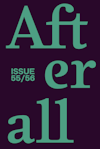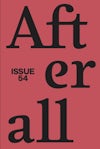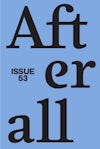
Issue 40
Autumn/Winter 2015
The Autumn/Winter 2015 issue considers the organisational turn in contemporay art through the work of Arturas Raila, Park McArthur, Andrzej Wróblewski and Lav Diaz. Additional essays assess dOCUMENTA (13)’s incursion into Kabul and the legacies of pan-Arabism in recent art.
Editors: Zachary Cahill, Melissa Gronlund, Anders Kreuger, Helena Vilalta, David Morris, Louise O’Hare.
Founding editors: Charles Esche, Mark Lewis.
Table of contents
Foreword
Contextual Essays
- Social Media: Practices of (In)Visibility in Contemporary Art – Sven Lütticken
- Insurgency and Circumspection: The Legacies of Pan-Arabism – Andrew Stefan Weiner
Artists
Art?ras Raila
- ‘The Diagnosis is Naïvety’: Art?ras Raila’s Journey into the Woods – Travis Jeppesen
- Navigating Through Chaos with Art?ras Raila – Lolita Jablonskien?
Park McArthur
- Park McArthur: Geometry, Material, Scale – Andrew Blackley
Renzo Martens
- Gentrification After Institutional Critique: On Renzo Martens’s Institute for Human Activities – T.J. Demos
Lav Diaz
- Long Walk to Life: The Films of Lav Diaz – May Adadol Ingawanij
Events, Works, Exhibitions
- The Artist as Director: ‘Artist Organisations International’ and its Contradictions – Ekaterina Degot
- Aftermaths?: dOCUMENTA (13) in Kabul – Francesca Recchia
- Andrzej Wróblewski, Our Contemporary – Tom McDonough
Foreword
Written by Charles Esche
A crisis of values stalks this issue of Afterall. Or, rather, a series of crises stalks these pages — ones that originate at different times and places but collide not only here but also in our contemporary world at large. Appraisals of artists Renzo Martens, Park McArthur, Artūras Raila, Lav Diaz and Andrzej Wróblewski are interwoven with contextual essays that complement and extend their artistic concerns with an examination of the ethics and exclusions of contemporary art. While the media that is addressed in the writing is radically diverse — from painting to film to institutional formation — the sense of a deep questioning of the values that should or can be promulgated within, alongside or entirely removed from the art world is consistently maintained. If there is a single point of departure in this issue, then it is (again) the monumental failure of communism to offer a way forward for modernity. This failure crops up in Ekaterina Degot’s comment on the Berlin meeting of ‘Artist Organisations International’ earlier this year: ‘between the revolutionary mood of the set and the general depressive-as-usual tone of the presentations — between ideal and reality, if I may — there was an interesting gap, a telling disjuncture, so wide that it is impossible to bridge in one swoop’. A similar disjuncture, one that extends the formal into the ethical realm, is also found in Wróblewski’s fascinating pictorial and personal struggles with the new order that was imposed on Poland after the end of the World War II. Indeed, perhaps the reason Wróblewski is emerging into international artistic view at precisely this moment in time is because his work and his life resonate so closely with contemporary experience.
As grandchildren of the communist catastrophe, the other artists brought together in these pages seem to be searching for a different, but related, set of values to Wróblewski’s ‘discredited “former communist”’. These values might offer some resistance to the decadence and increasingly obvious corruption of the global order, but their crisis is precisely in their incapacity to point to an elsewhere, let alone bridge the gap in a single swoop. While they might critique and act against, they are not in any condition to replace or wreck the existing order. Raila, McArthur, Diaz, Martens, but also the troubling dOCUMENTA (13) project in Kabul, the ambiguous echoes of historical pan-Arabism in works by Samah Hijawi and Basel Abbas and Ruanne Abou-Rahme as discussed by Andrew Weiner, or Jonas Staal’s, Ahmet Öğüt’s and Tania Bruguera’s projects as referenced by Sven Lütticken, all appear then to be suspended mid dive across Degot’s unbridged canyon. They swing between the values they want to leave behind and the construction of a reliable landing ground on the other side.
The struggles of these artists to occupy this vertiginous territory is admirable and important for a visual art field that might otherwise slip into helpless complacency and compromise. Their projects point out ways in which art’s modernist legacy, and above all its attraction to dissensus and deviance, can be renewed in contemporary times. They also serve as seismographs of an even more profound crisis of values in the wider society of which they are so much a part.
This broader crisis is perhaps best understood through looking back at one of the political figures that has shaped the former West’s value systems over the last two decades. In 2007, Tony Blair wrote an important text called ‘A Battle for Global Values’ for the US magazine Foreign Affairs. In it, he retrospectively tries to justify the ‘War on Terror’ that he had continuously waged in different functions since 2001 (and which continues today). He starts his exculpation of his order to invade Iraq not by setting out his global values as such (they are apparently too self-evident to need explication), but by explaining how they can successfully be defended:
We can win only by showing that our values are stronger, better and more just than the alternative. That also means showing the world that we are even-handed and fair in our application of those values. We will never get real support for the tough actions that may well be essential to safeguarding our way of life unless we also attack global poverty, environmental degradation and injustice with equal vigour.
Purchase
The publication is available for purchase. If you would like specific articles only, it is also available individually and to be downloaded as PDFs.
Purchase full publication
Buy via University of Chicago Press
Buy via Central Books
Purchase individual articles
Buy via University of Chicago Press



